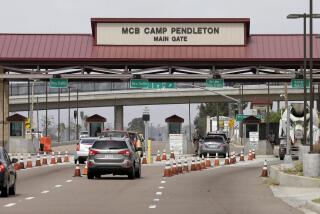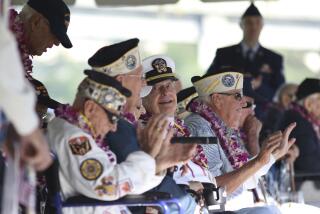Navy Panel Will Consider Charges Against Sub Crew
- Share via
WASHINGTON — The Navy will convene a court of inquiry, the service’s highest administrative proceeding, to consider possible criminal charges against three officers involved in the collision of a Navy submarine and a Japanese fishing boat that left nine people missing and presumed dead, officials said Saturday.
Adm. Thomas B. Fargo, commander of the U.S. Pacific Fleet, said the inquiry will examine whether the Navy should convene courts-martial for the skipper of the Greeneville, Cmdr. Scott Waddle, as well as for the executive officer, Lt. Cmdr. Gerald K. Pfeifer, and the officer of the deck, Lt. j.g. Michael J. Coen.
“The seriousness in which I view this tragic accident is reflected in the level of investigation and the seniority of the court members,” Fargo said at a news conference in Honolulu. The inquiry “will provide a full and open accounting for the American and Japanese people.”
The Greeneville, a nuclear attack sub, collided Feb. 9 with the trawler Ehime Maru when the submarine was carrying out a rapid emergency surfacing drill nine miles south of Honolulu. Nine people, including five who were students at a Japanese commercial fisheries high school, were lost and are presumed dead after the sub pierced the hull of the trawler, sending it more than 2,000 feet to the ocean floor.
The wreckage of the boat was discovered late Friday night about 1,000 yards from where the collision occurred.
The court of inquiry, which will meet for the first time Thursday, will consist of Vice Adm. John B. Nathman, commander of the Pacific Fleet’s aircraft; Rear Adm. Paul F. Sullivan, director of plans and policy for U.S. Strategic Command; and Rear Adm. David Stone, commander of Cruiser Destroyer Group Five.
Fargo said the court would look into disciplinary questions but also make other recommendations “as to the circumstances surrounding the accident.”
The incident has badly strained relations between the United States and Japan, especially after the disclosure that the submarine was carrying 16 U.S. civilians on the exercise as part of a public relations program.
The choice of a formal court of inquiry reflects the high stakes involved in the case. The incident has become a major diplomatic issue between the United States and Japan, and senior Japanese government officials have expressed their outrage at the accident and demanded a full accounting.
The tragedy has raised questions about allowing civilians to participate in such exercises. The Navy has temporarily halted the practice, which is under review.
The court of inquiry can take sworn testimony and will be able to subpoena witnesses. The proceeding will be very much like a court proceeding and can last for several weeks. If the inquiry finds that courts-martial are appropriate, they will follow immediately after the inquiry reaches its results.
Besides the three Navy admirals, a member of the Japanese Self Defense Force, the country’s military, will be invited to participate as a court advisor.
Fargo could have chosen several other routes: He could have called for a judge advocate general manual investigation, which is a quicker and less formal approach and does not take sworn testimony. Or he could have relied on a so-called board of inquiry, which is slightly more formal than the so-called JAG manual.
A JAG manual was used in the investigation of the Oct. 12 bombing of the Navy destroyer Cole by terrorists in Aden, Yemen. In that case, Navy officials signaled from the beginning that they didn’t believe the ship’s crew was responsible for the attack.
Fargo declined to release the contents of a preliminary investigative report written after a one-week study of the accident by investigators, lawyers and other aides.
That report was to probe the many lingering mysteries of the accident. It still is unclear how the sub could have missed sighting the trawler, despite multiple scans of the surface with its periscope and use of its sonar.
Also unclear is whether the visitors may have interfered with the crew in the cramped control tower and other areas of the 360-foot submarine.
At a hearing Wednesday before a Senate panel, Fargo said he remained baffled as to how the crew could have failed to spot the trawler.
Yet it also is not clear that the officers violated procedures. Two of the visitors on the sub maintain that the skipper and deck officers used the periscope with care and that the crew was operating the sonar to search for ships just before the crash.
Under the rules, the officers are subject to punishment if they fail to follow prescribed procedures.
Fargo said the court of inquiry “will recommend administrative or disciplinary action if appropriate, as well as make any other recommendations as to the circumstances surrounding the accident.”
The Navy reassigned Waddle, 41, of Austin, Texas, after the Greeneville arrived at port in Honolulu last weekend.
Also Saturday, Fargo released the names of the 16 civilians aboard the Greeneville when it hit the Ehime Maru.
They included two visitors from Kansas, two from Massachusetts, eight from Texas, two from Hawaii and two from Colorado.
Two civilians were at control positions when it surfaced under the Japanese trawler.
(BEGIN TEXT OF INFOBOX / INFOGRAPHIC)
Civilians on Board
The Navy on Saturday released the names of the 16 civilians who were aboard the submarine Greeneville when it collided with a Japanese fishing vessel Feb. 9 off Honolulu. Some of the names had been released earlier.
* Jay and Carol Brehmer of Overland Park, Kan.
* Jack and Pat Clary of Stow, Mass.
* Helen Cullen of Houston
* John M. and Leigh Anne Schnell Hall of Sealy, Texas
* Mike Mitchell of Irving, Texas
* Mickey and Susan Nolan of Honolulu
* Anthony and Susan Schnur of The Woodlands, Texas
* Todd and Deanda Thoman of Houston
* Ken and Catherine Graham Wyatt of Golden, Colo.
More to Read
Sign up for Essential California
The most important California stories and recommendations in your inbox every morning.
You may occasionally receive promotional content from the Los Angeles Times.














